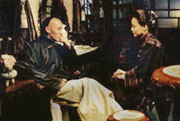Th e Death of Mr. Lazarescu, 2005. Something of a hybrid between the sardonic humor of a talkative Otar Iosseliani or Béla Tarr and the vérité-like, social realism of Jean-Pierre and Luc Dardenne, Cristi Puiu’s The Death of Mr. Lazarescu is a thoughtful and incisive slice-of-life comedy on the impersonalization (and desensitization) of institutional health care. Exploring similar issues of entrenched bureaucracy as Moussa Bathily’s Le Certificat d’Indigence that serve to impede the proper dispensation of proper medical care (and, more importantly, lose sight of the face of humanity behind human suffering), the film unfolds as an absurd subversion of Leo Tolstoy’s The Death of Ivan Ilych in which the isolative process of dying becomes occluded in the pettiness, moralizing, helplessness, and coincidental distractions that invariably occupy everyday life as the lonely widower and retired engineer, Larazescu, is scuttled from one hospital to another throughout the evening after suffering from a bout of migraine and nausea. As in Tolstoy’s novella, the process of death does not alter the process of living, but rather, becomes only a momentary distraction in an eternal – and seemingly interminable – human comedy.
e Death of Mr. Lazarescu, 2005. Something of a hybrid between the sardonic humor of a talkative Otar Iosseliani or Béla Tarr and the vérité-like, social realism of Jean-Pierre and Luc Dardenne, Cristi Puiu’s The Death of Mr. Lazarescu is a thoughtful and incisive slice-of-life comedy on the impersonalization (and desensitization) of institutional health care. Exploring similar issues of entrenched bureaucracy as Moussa Bathily’s Le Certificat d’Indigence that serve to impede the proper dispensation of proper medical care (and, more importantly, lose sight of the face of humanity behind human suffering), the film unfolds as an absurd subversion of Leo Tolstoy’s The Death of Ivan Ilych in which the isolative process of dying becomes occluded in the pettiness, moralizing, helplessness, and coincidental distractions that invariably occupy everyday life as the lonely widower and retired engineer, Larazescu, is scuttled from one hospital to another throughout the evening after suffering from a bout of migraine and nausea. As in Tolstoy’s novella, the process of death does not alter the process of living, but rather, becomes only a momentary distraction in an eternal – and seemingly interminable – human comedy.
 Three Times, 2005. After two films that admittedly left me uncertain over the direction of Hou Hsiao Hsien’s cinema, it was particularly satisfying to see Hou incorporate his earlier (and specifically, more overtly political) films with his recent expositions into more distilled and highly elliptical mood pieces. Evoking Chantal Akerman’s Toute une nuit in its essential distillation of singular, transformative episodes that define the formative substance of all romantic relationships, Three Times presents a series of vignettes, each chronicling a series of understated encounters between two lovers played by same actors Chang Chen and Shu Qi, as their destinies weave through the complex socio-political terrain throughout the last century of Taiwanese history. Set in a 1966 rural province, the first chapter A Time of Love recalls the nostalgic innocence of young love of Hou’s earlier film Dust in the Wind as a young man spends the few remaining days of his civilian life at a billiard parlor before reporting for compulsory military service and falls for the parlor’s attractive, new employee. Infused with a tonal romanticism of unarticulated longing that rivals the atmospheric texturality of a Wong kar-wai retro period piece, Hou’s melodic rendition is imbued with a poetry of sensually charged gestures and understated intimacy.
Three Times, 2005. After two films that admittedly left me uncertain over the direction of Hou Hsiao Hsien’s cinema, it was particularly satisfying to see Hou incorporate his earlier (and specifically, more overtly political) films with his recent expositions into more distilled and highly elliptical mood pieces. Evoking Chantal Akerman’s Toute une nuit in its essential distillation of singular, transformative episodes that define the formative substance of all romantic relationships, Three Times presents a series of vignettes, each chronicling a series of understated encounters between two lovers played by same actors Chang Chen and Shu Qi, as their destinies weave through the complex socio-political terrain throughout the last century of Taiwanese history. Set in a 1966 rural province, the first chapter A Time of Love recalls the nostalgic innocence of young love of Hou’s earlier film Dust in the Wind as a young man spends the few remaining days of his civilian life at a billiard parlor before reporting for compulsory military service and falls for the parlor’s attractive, new employee. Infused with a tonal romanticism of unarticulated longing that rivals the atmospheric texturality of a Wong kar-wai retro period piece, Hou’s melodic rendition is imbued with a poetry of sensually charged gestures and understated intimacy.
The second chapter, A Time for Freedom unfolds as a silent film variation of Flowers of Shanghai. Set at a brothel in 1911 during the Japanese occupation of Taiwan, the film follows the evolving relationship between a highly influential newspaper editor (and political activist) and a courtesan approaching the age of marriage who is prompted to re-evaluate her own future when her patron decides to intervene in the fate of one of the junior courtesans. Retaining the atmosphere of insularity that pervades Hou’s earlier film, the episode similarly reflects Taiwan’s increasing estrangement from mainland China at the turn of the century while presenting a social critique on the consuming national and sexual politics of the times.
The third chapter, a contemporary piece set in Taipei entitled A Time for Youth recreates the modern-day rootlessness of Goodbye South Goodbye (sans implicit humor) and Millennium Mambo as a young couple lead an aimless existence of club hopping, wordless intimacy, and escapist motorcycle rides through town. Replacing the stylized, melancholic romanticism of the earlier chapters with a dedramatized, alienated realism, Hou illustrates a sense of estrangement borne, not of external circumstances, but of a pervasive spiritual inertia. Expounding on similar themes of absent parents, broken communication, and missed connection that Hou explores in his previous film, Café Lumière, the film becomes an elegy, not for the nostalgia of a bygone era, but of lost opportunity in an age of liberation.
 The Sun, 2005. Aleksandr Sokurov has always seemed to be particularly in his element with his dense and amorphous expositions of integrated, Eastern spirituality (A Humble Life, Dolce) and the commutation of collective history (Oriental Elegy, Russian Ark, so it comes as no suprise that the third installment of his historical tetralogy, The Sun – a film that incorporates both aspects of these recurring themes – is his most accomplished (to date) of the series. Rendering a painstainkingly detailed portrait, not of the biographical life of Hirohito (Issei Ogata), the (hu)man, but rather, of the culturally unquestioned institution of the divine Emperor of Japan, Sokurov’s vision eschews the conventional framework of illustrating the turmoil and decimation of the waning days of war in order to present a more challenging and illuminating portrait of a physically slight, pensive, and perhaps reluctant national ruler trapped in the eternal performance of traditional rituals and bound to the rigid social codes of his inherited role. From the opening sequence of the emperor impassively listening to his itinerary for the day over a private breakfast – including his exact hour for catching an afternoon nap – the film provides an image of the imprisoning rituals – and consuming weight – of assumed power. The selection of Richard Wagner’s elegiac compositions (Wagner also composd the magnum opus operatic tetralogy, the Ring Cycle) seems especially suited to this twentieth century portait of götterdämmerung, chronicling the literal twilight of the sun god, as the defeated Japanese emperor transforms from deity to mere mortal after his official surrender to General Douglas MacArthur (Robert Dawson) and the American occupiers. However, even more than the actions of Hirohito himself, the film’s incisive study of the cultural framework that underpins the source of the emperor’s absolute power provides a particularly relevant context to Sokurov’s expositions on the dynamics of power and (false) idolatry, most notably in the filmmaker’s treatment of the mythification of a political leader that seems eerily resonant of contemporary American politics in which a destructive culture of unquestioned faith, intractable policies, isolationism, and evocation of divine rule serves to unwittingly precipitate the nation’s own predestined failure and international marginalization.
The Sun, 2005. Aleksandr Sokurov has always seemed to be particularly in his element with his dense and amorphous expositions of integrated, Eastern spirituality (A Humble Life, Dolce) and the commutation of collective history (Oriental Elegy, Russian Ark, so it comes as no suprise that the third installment of his historical tetralogy, The Sun – a film that incorporates both aspects of these recurring themes – is his most accomplished (to date) of the series. Rendering a painstainkingly detailed portrait, not of the biographical life of Hirohito (Issei Ogata), the (hu)man, but rather, of the culturally unquestioned institution of the divine Emperor of Japan, Sokurov’s vision eschews the conventional framework of illustrating the turmoil and decimation of the waning days of war in order to present a more challenging and illuminating portrait of a physically slight, pensive, and perhaps reluctant national ruler trapped in the eternal performance of traditional rituals and bound to the rigid social codes of his inherited role. From the opening sequence of the emperor impassively listening to his itinerary for the day over a private breakfast – including his exact hour for catching an afternoon nap – the film provides an image of the imprisoning rituals – and consuming weight – of assumed power. The selection of Richard Wagner’s elegiac compositions (Wagner also composd the magnum opus operatic tetralogy, the Ring Cycle) seems especially suited to this twentieth century portait of götterdämmerung, chronicling the literal twilight of the sun god, as the defeated Japanese emperor transforms from deity to mere mortal after his official surrender to General Douglas MacArthur (Robert Dawson) and the American occupiers. However, even more than the actions of Hirohito himself, the film’s incisive study of the cultural framework that underpins the source of the emperor’s absolute power provides a particularly relevant context to Sokurov’s expositions on the dynamics of power and (false) idolatry, most notably in the filmmaker’s treatment of the mythification of a political leader that seems eerily resonant of contemporary American politics in which a destructive culture of unquestioned faith, intractable policies, isolationism, and evocation of divine rule serves to unwittingly precipitate the nation’s own predestined failure and international marginalization.
Something Like Happiness, 2005. Near the halfway mark of the first week at the festival, Bohdan Slama’s exquisitely rendered Something Like Happiness provides a good-natured, refreshing, leisurely paced, and satisfying palate cleanser: a slice-of-life serio-comedy on devotion, friendship, family, and missed connection. At the heart of the film is the scruffy bohemian, a perennial “sweet guy” named Tonik (Pavel Liska) who lives with his aunt in a derelict house on a scrap of land overlooking a sprawling industrial complex in which they are two of the few remaining holdouts in a proposed factory expansion project (long after other residents, including his own parents, have moved into residential apartments with all modern conveniences). Secretly carrying a torch for his childhood best friend, a beautiful store clerk named Monika (Tatiana Vilhelmová), his prospects for winning her heart prove ever fading when, at the start of the film, her dashing and affable boyfriend immigrates to America and subsequently sends her a ticket to join him after he secures a steady job for both of them. However, when the Tonik and Monika become unexpected custodians to a pair of young boys after their mother is institutionalized, her decision to defer her trip until her release from the hospital provides the shy Tonik with a glimmer of hope for their long awaited romantic union. Like the character Tonik, the film is also gentle and unassuming, but ultimately haunting and endearing portrait of compassion, unrequited longing, and human dignity.
Capote, 2005. During the Q&A for the film, actor Philip Seymour Hoffman commented that the inspiration behind his remarkable transformation into the character of novelist Truman Capote came from the idea of someone who needed the other person much more than the other needed him, but concealed this lopsided dependence in such a manner that the other believes the reverse. This posture provides an insightful glimpse, not only into the controversial relationship between Truman and Perry (Clifton Collins, Jr.) one of the killers of the Clutter family whose senseless murder served as the basis for his non-fiction novel In Cold Blood, but also in his self-consumption and eccentricity. From the opening sequence recreating the discovery of the bodies in the Klutter family in their Kansas farmhouse that cuts into the image of Capote transfixedly reading the article on the murder from his New York City apartment (figuratively holding the open ended resolution of their deaths in his hands), filmmaker Bennett Miller creates a sense of interconnected fatedness in this chance “encounter”, a compulsion that would propel him to visit Kansas with his childhood friend (and implicit beard) Nell Harper Lee (Catherine Keener). While I disagree with Bennett’s characterization of Truman as a narcissist but rather, as an insecure outsider whose abandonment as a child led him to perpetually seek attention, the film achieves resonance into Capote’s true character (and ties into the theme of fate) in a scene in which Truman describes Perry as coming from the same house, an image of himself who left through the back door, while he left through the front.
 Dorota Kedzierzawska continues to demonstrate her strength in directing young actors (particularly evident in the performance of the lead actor, Piotr Jagielski) that she had earlier illustrated in The Crows with her latest film I Am. Recalling Ken Loach’s Kes or Hirokazu Kore-eda’s Nobody Knows in its modern day, pseudo-Dickensian tale of instinctual survival shot from a child’s perspective, the film is a familiar story of a neglected, troubled child’s fugue, retreat into a makeshift world of his own imagined creation, and inevitable return to the “outside” world, I Am renders a less metaphoric journey for parental connection in a similarly suffused and foreboding vein of Andrei Zvyagintsev’s Return). However, while Kedzierzawska’s execution is impeccable and remarkably adept, the film, nevertheless, retains an oddly sterile conventionality to its manner of storytelling, an impression that is further reinforced by composer Michael Nyman’s swelling and overwrought (if not patently manipulative) soundtrack that suffuses each dramatic scene with an inconguent, near-mythic sense of tragedy.
Dorota Kedzierzawska continues to demonstrate her strength in directing young actors (particularly evident in the performance of the lead actor, Piotr Jagielski) that she had earlier illustrated in The Crows with her latest film I Am. Recalling Ken Loach’s Kes or Hirokazu Kore-eda’s Nobody Knows in its modern day, pseudo-Dickensian tale of instinctual survival shot from a child’s perspective, the film is a familiar story of a neglected, troubled child’s fugue, retreat into a makeshift world of his own imagined creation, and inevitable return to the “outside” world, I Am renders a less metaphoric journey for parental connection in a similarly suffused and foreboding vein of Andrei Zvyagintsev’s Return). However, while Kedzierzawska’s execution is impeccable and remarkably adept, the film, nevertheless, retains an oddly sterile conventionality to its manner of storytelling, an impression that is further reinforced by composer Michael Nyman’s swelling and overwrought (if not patently manipulative) soundtrack that suffuses each dramatic scene with an inconguent, near-mythic sense of tragedy.
Bubble, 2005. The title of the film provides a glimpse into the fragility of the hollow, empty life led by the main character: a middle-aged airbrush operator at an Ohio doll factory named Martha (Debbie Doebereiner) who takes cares for her invalid father, shuttles her car-less, twentysomething best friend and fellow factory worker Kyle (Dustin James Ashley) to his second job in neighboring West Virginia, and spends her evenings sewing doll clothes. It is a predictable routine that is soon perturbated when the company foreman hires a second airbrush operator named Rose (Misty Dawn Wilkins) to ramp-up production for a large order, a nebulous, young single mother with a penchant for stealing. Shot with a cast of non-professional actors, Steven Soderbergh’s low budget indie film Bubble has the signature look – and rides the familiar clichés – of an independent film set in rural America: pot-smoking, high school drop-out blue collar workers, dysfunctional family lives (burdensome and unemployed parents, volatile ex-boyfriends, a steady diet of fast food), and distended sequences of dead time. Skirting the narrative and muted emotional arc of monotonic ritual, betrayal, and senseless violence, the characters’ lives – like the film itself – are reflected in the dolls of their creation: fractured, colorless, inanimate, and underformed.
Avenge But One of My Two Eyes, 2005. Films about the effects of Israeli occupation on the Palestianian population are always bound to be inflammatory and subject to often unfair, prejudicial criticism of justifying terrorism, and this ugliness unfortunately surfaced from a particularly hostile member of the audience at the Q&A with filmmaker Avi Mograbi for his penetrating documentary Avenge But One of My Two Eyes. At the heart of Mograbi’s organic essay is the juxtaposition of two events. The first is the ancient history of the mass suicide of the zealots at Masada during the Jewish Revolt as a final act of defiance against an inevitable Roman capture. The second is the Biblical text of the emasculated, blinded, and captured Nazirite Samson standing between the main pillars of the temple who implored God to find the strength to “avenge but one of my two eyes” (a phrase that, coincidentally, is also used in a rallying song by the minority militant, right-wing settlers), collapsing the temple – which brought his own death – in such a way that he killed more Philistines with his final act of suicidal retribution than during his lifetime. While the film does not inherently correlate the defiant act of the Masada with the modern-day act of suicide bombing, it was the juxtaposition of these two ideas that clearly vexed a few people. However, rather than directly commenting on the suicide bombing as a consequence of the occupation, the film instead explores the psychology behind the egregious act, laying bare the underlying callous indifference, insensitivity, racism, and uncertainty that the occupation has caused in the conduct of everyday life for the Palestinians: an ambulance carrying a seriously ill woman is physically blockaded by two armor tanks and repeatedly ordered to go home, refusing any pleas from the anxious husband and her family with the terse response “I don’t care. Go home!” broadcasted through a megaphone; a group of farmers who must cross a checkpoint in order to harvest their olives are refused permission to enter because of military exercises and denied information for a set time that they can return in order to be admitted entry; a group of young schoolchildren returning from school are refused passage through the checkpoint gates under “military orders” that the soldiers refuse to present. Mograbi’s vérité-styled filmmaking effectively captures the turbulence, humiliation, and uncertainty of occupation, presenting a thoughtful and incisive call to action for the return of humanity in increasingly entrenched and inhuman times.
 L’Enfant, 2005. There is a palpable spirit of Robert Bresson (most notably Pickpocket and L’Argent) and Fyodor Dostoevsky’s Crime and Punishment at work in Jean-Pierre and Luc Dardenne’s L’Enfant, so it comes as no surprise that during the subsequent Q&A, the brothers remarked that one of the images that they had wanted to capture in the film was how the fallen hero, a petty thief and new father Bruno (Jérémie Régnier), learns to “see the woman facing him”. This woman (Déborah François), appropriately named Sonia, is a Dostoevsky archetypal chracter: devoted, suffering, taken for granted. As in the Dardenne’s earlier film, The Son, the “child” of the film is also a figurative embodiment of redemption that is defined by more than one character: the newborn son Jimmy who is sold by his father on a whim, the immature Bruno, a flightly and rootless young man who sees his son as a disposable accessory, the band of young boys recruited by Bruno to perpetrate the petty crimes for a share of the profits. In this respect, the repeated shots of Bruno aggressively pushing the pram through the streets (and subsequently, in a situational permutation of him pushing a scooter) becomes a refiguration of Raskolnikov’s dream: an image of burden, reluctant responsibility, and duty.
L’Enfant, 2005. There is a palpable spirit of Robert Bresson (most notably Pickpocket and L’Argent) and Fyodor Dostoevsky’s Crime and Punishment at work in Jean-Pierre and Luc Dardenne’s L’Enfant, so it comes as no surprise that during the subsequent Q&A, the brothers remarked that one of the images that they had wanted to capture in the film was how the fallen hero, a petty thief and new father Bruno (Jérémie Régnier), learns to “see the woman facing him”. This woman (Déborah François), appropriately named Sonia, is a Dostoevsky archetypal chracter: devoted, suffering, taken for granted. As in the Dardenne’s earlier film, The Son, the “child” of the film is also a figurative embodiment of redemption that is defined by more than one character: the newborn son Jimmy who is sold by his father on a whim, the immature Bruno, a flightly and rootless young man who sees his son as a disposable accessory, the band of young boys recruited by Bruno to perpetrate the petty crimes for a share of the profits. In this respect, the repeated shots of Bruno aggressively pushing the pram through the streets (and subsequently, in a situational permutation of him pushing a scooter) becomes a refiguration of Raskolnikov’s dream: an image of burden, reluctant responsibility, and duty.
 Regular Lovers, 2005. Regular Lovers is a quintessential Philippe Garrel film. Part self-exorcism of the failed idealism of the May 68 counter-culture revolution that inevitably burned out in a haze of recreational drug use, sexual liberation, and the inertia of bohemianism, and part elegy on love found in the wreckage of a heartbreaking aftermath that, too, becomes inevitably lost, the film follows the plight of a young poet and draft dodger, François, as he devolves from impassioned idealist and revolutionary, to hopeless romantic (who once – perhaps, half-heartedly – offered to put aside his art and find a wage-earning vocation in order to provide a more stable life for his new lover, Lilie), and eventually, to adrift bohemian and parasitic houseguest. The film’s final sequence – an evocation of the romanticism of revolution – is a fitting double entendre that recalls an earlier extended dream sequence of the French Revolution, as the latent potency of the dross opium becomes a metaphor, not only for the crystalized potential for upheaval and (self)destruction that continues to sublimate within the souls of a consumed and demoralized May 68 generation, but also, in its stabilized, incombustible form, represents the consumed residue of a transitory and ephemeral moment of bliss and paradise lost.
Regular Lovers, 2005. Regular Lovers is a quintessential Philippe Garrel film. Part self-exorcism of the failed idealism of the May 68 counter-culture revolution that inevitably burned out in a haze of recreational drug use, sexual liberation, and the inertia of bohemianism, and part elegy on love found in the wreckage of a heartbreaking aftermath that, too, becomes inevitably lost, the film follows the plight of a young poet and draft dodger, François, as he devolves from impassioned idealist and revolutionary, to hopeless romantic (who once – perhaps, half-heartedly – offered to put aside his art and find a wage-earning vocation in order to provide a more stable life for his new lover, Lilie), and eventually, to adrift bohemian and parasitic houseguest. The film’s final sequence – an evocation of the romanticism of revolution – is a fitting double entendre that recalls an earlier extended dream sequence of the French Revolution, as the latent potency of the dross opium becomes a metaphor, not only for the crystalized potential for upheaval and (self)destruction that continues to sublimate within the souls of a consumed and demoralized May 68 generation, but also, in its stabilized, incombustible form, represents the consumed residue of a transitory and ephemeral moment of bliss and paradise lost.
Caché, 2005. Michael Haneke’s latest offering, Caché brilliantly converges towards early Harun Farocki themes of surveillance and terrorism though images while retaining his own recurring themes on the abstraction of videoimage representation (as in The Seventh Continent), the desensitization of images (as in Benny’s Video), and the breakdown of (social) order as a consequence of failed communication (as in Code Inconnu) to create a challenging and provocative examination of guilt, complacency, and reckoning. From the opening stationary image of a quiet suburban neighborhood that begins to display video tracking marks, revealing the surveillance nature of the recorded image (as Georges (Daniel Auteuil) and Anne (Juliette Binoche) study the anonymously recorded tape of the front of their house for clues on its origin), Haneke presents a literal self-projection of the characters’ actions (and implicitly, our own) that serves as a mirror to examine human conscience and collective responsibility. Moreover, as the frequency and unsettling specificity of the mysterious video correspondence escalates to include child-like, crudely drawn images of seemingly intimate knowledge from incidents from Georges’ childhood – in particular, his one-sided rivalry with his Algerian “almost” brother, Majid (Maurice Benichou) for his parents’ attention – the tone soberingly shifts from sinister mystery and critical self-assessment (and national, as in the case of the massacre of Algerian residents by French authorities in 1961) to one of exposing the baseness of instinctual human behavior that manifests in destructive, inhuman acts of crippling paranoia, racism, misdirected blind aggression (as in the case of the couple’s near collision with a cyclist on a one-way road, an episode that hauntingly recalls the catalytic encounter of Code Inconnu), and self-righteous retaliation. The film’s penultimate sequence of Georges’ surveillance-like, regressive dream into the pivotal episode that lies at the core of his childhood guilt, captured from a stationary, medium shot camera recalls the framing of the opening sequence (as well as prefigures the concluding sequence), establishing a connection between the two visually innocuous – but implicitly traumatic images: an omniscient view, not from a distant, God’s eye perspective, but from an equally inescapable perspective of personal conscience.
Acquarello, 2005 [reprinted]